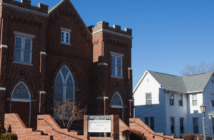Minnesota Pastor Lee Ann Pomrenke reflects on the painful reality of having to bring a congregation or a ministry to an end. While there is a tendency to see closure as a failure and assign blame, she considers how closing a congregation can be an act of faithfulness and responsible stewardship that can open the way to new life.
The 10-year-old mission start I was serving was headed toward closing. It was a suburban congregation of mostly families and children surrounded by large churches of the same denomination. There were no elderly people, no building to sell, and few assets to disperse. The history they had to mourn and celebrate was relatively short, but deeply meaningful to those who remained. A more experienced interim pastor, who had closed two older, urban congregations, helped me see that while ours was not the usual story of a congregation closing, it still brought the heart of the matter into sharp focus: closing this ministry was not failure, it was a way of living faithfully.
When the number of people dwindles, and resources start to run out, the tendency is to try to stretch them, even to the breaking point. But redirecting passions and resources into a ministry that can use them well is an expression of faithful stewardship.
Confession and Forgiveness
Most church leadership resources focus on rethinking or kickstarting a ministry in decline. This desire easily translates into assigning blame when things don’t turn around. There is likely to be a bombardment of suggestions or strategies from “helpful” outsiders, especially when the ministry’s closing is made public. Anyone vaguely connected might ask, “Did you try this?” or “What went wrong?”
So, our first practice of faithfulness was confession and forgiveness. Church systems, much like families, are complex organisms. There is usually a web of interconnected causes and reactions amidst conflict. There are things everyone could have done differently in the past, but we can only respond to the present moment. We can each examine and confess our own thoughts and actions done or left undone. Then declare to each other, by the command of Christ, the entire forgiveness of all our sins. This is faithfulness.
Resurrection after Death
We are resurrection people, but resurrection comes only after death. So, the death of a ministry requires a lot of faith in the promise of resurrection. The story that resonated deeply was that of the women at the end of Mark’s Gospel, who knew the power of Jesus and his promise of the resurrection, yet still fled the empty tomb in fear. The congregation had diminished as families returned to the surrounding large churches when things got tough. They were emotionally exhausted and couldn’t yet see what resurrection could look like for them. Maybe no one would believe the power of Christ they had experienced in this community because of the ending.
We also read John’s account of Mary Magdalene weeping in the garden, but finally recognizing Jesus when he called her by name. This was the most crucial task of the tight-knit group, who could call each other by name and thereby reveal Jesus still alive and well in their midst. Their relationships were proof that Jesus foils death and brings new life, however unrecognizable it is at first. But nobody has been abandoned. Closing is not an indication that God has abandoned us or that we have abandoned God. Scripture bears witness to this, certainly, but so does our experience. When we are most bereaved, troubled, or feeling like failures, the Holy Spirit opens us to new possibilities. That’s a terrifying unknown, but one deeply rooted in God’s great faithfulness and commitment to us.
Faithful Stewardship
When the number of people dwindles, and their energy and resources start to run out, the tendency is to continually try to stretch them, even to the breaking point. But redirecting their passions and resources into a ministry that can use them well is an expression of faithful stewardship.
When the day came to vote about closure, our church council reviewed the five benchmarks they had set to inform their decision. Significantly, the one benchmark that had been satisfied was the financial goal. The bank account did not force the decision. This was an interpretive nudge. The story to be told was not that we were closing because money had run out but rather because we had discerned, with God’s help, that it would be more faithful to direct those resources into different ministries. God was calling us to more faithful stewardship.
When closing a long-lived congregation that peaked decades ago, it can be helpful to talk about the life cycle of congregations, along the lines of Ecclesiastes 3. For everything there is a season …. (See Ending with Hope: A Resource for Closing Congregations, Alban Institute, 2002.) While this narrative is not as applicable when closing a younger ministry, the need for solid theology remains the same. Whenever a congregation or ministry decides to close, consolidate, or partner with another ministry, those within and surrounding the congregation are called to be faithful to the Holy Spirit’s work through them, even in closing.
Related Resources
- What if Your Church Had No Building? by Jacob Armstrong
- Ending with Hope: A Resource for Closing Congregations by Beth Ann Gaede
- The Case of a Small Church in an Oversized Building by Lewis A. Parks






